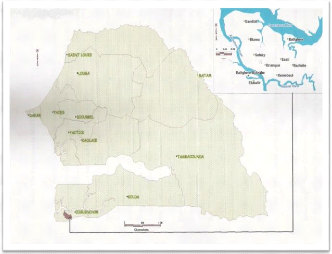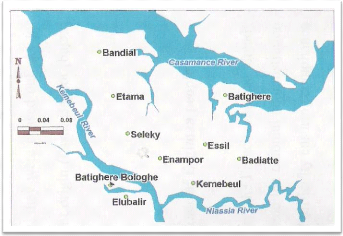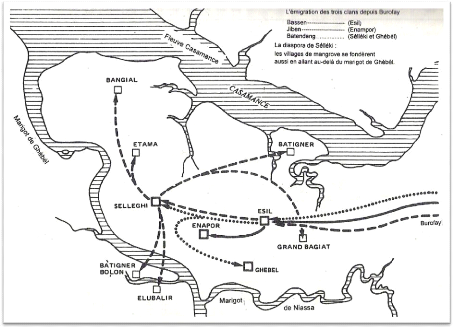I.P.A : International Phonetic Alphabet
L1 : First language
L2 : Second language
× : means «nothing»
Rad. : Radical
Suff. : Suffix
U.C.A.D : Université
Cheikh Anta Diop (University
of Dakar) V : Vowel
+v : Voiced
-v : Voiceless
GENERAL INTRODUCTION
Djola is a linguistic unit which, with Mandjako, Mankagna and
Balanta, constitutes the Bak sub-group of the West-Atlantic group, which
belongs to the great Niger-Congo family. It was classified in the West-Atlantic
group by Westermann and J. H. Greenberg . But French linguists Delafosse and
Lavergne de Tressan classified Djola
1
in what they called the Senegalo -Guinean group . The
classification of Greenberg, until now up to date, is the one retained for this
research work.
Djola is spoken in The Gambia, Senegal and Guinea-Bissau. It
is the language of the Djola people who occupy the area which extends on these
three countries. All over this linguistic shelf, Djola is respectively in
contact with English, French, Portuguese and other local languages.
Basing ourselves on the truism according to which when one or
more languages are in contact, they influence one another, we have chosen to
work on the influence of Djola on French in Senegal. In one word, this work
will be concerned with the study of the influence of a national language,
namely Djola, on the official one, French, in Senegal.
Senegal is a linguistic shelf where many languages are in
contact. From this contact arises the phenomenon of mutual-influence but we
will concentrate our work more on the study of the influence of Djola on French
than the contrary.
The Djola language, according to Sambou (1979), comprises
around fifteen dialects2. Among this set of dialects, our choice
laid on that commonly known as «Eegimaa». This choice is
justified by the fact that these people were in early contact with the
colonizers and that's the same for their language. Another reason is that their
location is very enclosed and thus less exposed to the phenomenon of
Wolofisation.
The dialect was variously named by the linguists who worked on
it: Palmeri called it Bandial, Doneux, Gusilay, while Odile
Tendeng, a native speaker, labeled it Endungo at the end of a long
term investigation.
To find a name in which all the speakers of the linguistically
delimited entity would recognize themselves, such was one of the concerns which
animated the researchers. In spite of the provided efforts, it appears today
that these denominations do
1 Pierre-Marie Sambou. 1979. Ç Djola Kaasaa
Esuulaalur: Phonologie, Morphophonologie et
Morphologie È. Thèse de de 3 ème
doctorat cycle, Dakar: Université de Dakar, Page 4
2 Refer to Chart 1, page 3 .
Bayot group Proper Djola


not cover the whole of the speech community, certain villages
feeling indicated by none of the three names. In order to answer this concern,
the name Eegimaa was selected designating the people of this
dialect.
Indeed, to be distinguished from other Djola people, the
native speakers call themselves: «ájoola eegimaa»,
which means: a Djola who uses the expression
«eegimaa» to say: «here is what I say to you ".
And this expression is very recurrent in the speech of this community.
Apart from these authors, we can find other people naming it «Djola
Essil» or even people from that area calling it
«Guláay» or «Gujólay
gamoyen».
In front of this situation of uncertainty, we have chosen to
label it «Eegimaa» because it is the one mostly used in the
academic sphere (Bassène 2001 and Bassène 2003) and we would not
depart from the rule. Even for the spelling of the word «Djola»
itself, we noticed many types (Diola, Dyola, Jóola and Jola), but we
will use «Djola» in this work.
We found an interest on this topic and it lays on the fact
that not only it is one in which we will be pioneers on researching and
findings from this work will be original ones but also because it will allow us
to study the contact between local and official languages in a multilingual
context.
To bring a true contribution to the present field of language
contact in multilingual societies, we have conducted a fieldwork in which we
tried to bring as much reliable data as possible. We went to
«Mofçvi3» in the department of Ziguinchor,
to Dakar and Saint-Louis where we found a high concentration of Eegimaa
people.
To collect these data, we proceeded by means of a
questionnaire in which people were asked to give their identification (names,
age, sex, address and country of birth) and also answered a limited set of
questions such as their mother tongue, other languages they speak or understand
and their level of study4 etc.
Apart from the questionnaire, we observed people speaking and
chose a sample of fifty persons (twenty five [25] from Ziguinchor and the
remaining 25 others from Dakar and Saint-Louis) whom we interviewed by means of
a voice recorder. The people interviewed were all native speakers of Eegimaa
aged between 15 and 66. All of them went to school for at least 7 years.
3 «Mof» is the word for land, soil
and «ávi» stands for both King and
hundred or cent franc CFA but here, it is for the first
meaning that prevails. Thus «Mof çvi» means the king's
land and is the original location of the Eegimaa people (for more information
see Map 1 and 2, page 4).
4 For more details see Appendix 2: Questionnaire, page
44.
This work will be divided into four main chapters. In Chapter
One, we will present these two languages giving their historical background in
the field of research. Then in Chapter Two, we will give a theoretical approach
concerning the description of the two languages of our study, all the theories
about languages in contact and the inventory of works related in some way or
other to ours. In Chapter Three, we will present the fieldwork and show in what
way we have conducted the data collec tion. And at last, in Chapter Four, we
will analyze the data we gathered during the fieldwork before giving the
findings and then conclude.
Chart 1: Classification of the Djola
group languages (ÒBAKÓ LANGUAGES
SUBDIVISION: Djola group)
DJOLA GROUP


Karone group Kwataay group Central Djola



Fogny group Kaassa group Ejamat group Gusilay group
*Fogny *Huluf *Ejamat *Gusilay
*Eegimaa
*Buluf *Ayun *Her
*Kombo *Selek *Elun
*Narang *Esuulaalur
*Fluvial
*Bliss
SOURCE: Translation and adaptation from Hopkins 2005, page
7.
Map 1: Localisation of Mof çvi whithin
Senegal

SOURCE: Bassène, Mamadou.
2003, page3.
Map 2: The Eegimaa speaking area

SOURCE: Bassène, Mamadou.
2003, page3.
CHAPTER ONE
***
Backgrounds
1- EEGIMAA IN CASAMANCE
The history of the establishment of the Eegimaa people in Mof
çv' is partly based on mythical stories on the one hand and real facts
on the other.
Thus, according to legend, all ethnic groups of Senegal were
said to come from Mecca where, they originally all live in peace: Serer, Djola,
Fulani, Mandingo etc. But once came the day when they had to separate from each
other because it was said that they were cramped for room. So, they decided to
break into pieces the «big black stone» used in pagan rituals and
allegedly called in Arabic «siat». This same noun is found
in the Eegimaa language and is the plural form of the word
«eat» which is also a black stone but of an unsettled size.
This stone is buried in the shrines.
Always according to legend, the Eegimaa people sojourned a
long time in the ancient Kingdom of Gaabu with the Fulani and the Mandingo.
After their sojourn in the empire of Gaabu, the Djola left and
moved northward until they reached the present region of Casamance precisely in
a place called Burofay where they lived peacefully with their fellows the
Ba
·nouk for a long period of time.
But according to Palmeri, at a certain period of their
cohabitation, drought cropped up and life with their fellows Ba
·nouk
became harsh leading to internal fights between them. The Ba
·nouk left
Burofay and settled in Brin where they live still now. The Eegimaa people as to
them, stayed there for a while before a hunter named
Djiméguéré discovered the bed of a stream in a place
somewhere between Badiat and Badjokotong. Once back to Burofay, he told the
king about his discovery and the latter sent three other hunters one from each
of the three clans composing the kingdom. They went there, came back and
confirmed what was said previously.
All Eegimaa people left Burofay together under the king of
that time named Djimanga and went westward to join Essil5. In their
way, they stopped over at Gunih and waited for the king who left last bringing
with him the fetishes called Ufulung.
Once in Essil, which is the first village to be occupied
officially by the Eegimaa, the families began to spread out all around the new
lands. Thus, the Bassène stopped in Essil. The Jiben clan, composed by
different families: the Sagna, Manga, Sambou, Diatta and the Aghène
continued further and stopped in Enampor; while the Batendeng clan which was
the most numerous, occupied the villages of Séléki and
Gheubeul.
5 For more details, see Map 3: Migration from Burofay towards Mof
Ávi, page 7.
After a certain number of years spent in the newly discovered
lands, a quarrel broke out in the royal family of Enampor, which caused its
scission. This family broke up into two branches: the Manga remained in Enampor
and the Sagna took refuge in Essil carrying with them their respective
fetishes. From this moment on, the royalty belonged alternatively to Manga and
Sagna families and the "kings" are selected once in Enampor and the following
time in Essil.
This tradition of royalty in Mof Av' lived on until 1978 with the
death of Affilédio Manga6 the last
«king-priest-of-the-rain».
Map 3: Migration from Burofay towards
Mofçvi

SOURCE: Palmeri, Paolo. 1995, page 77.
7
2- FRENCH IN CASAMANCE
6 See Appendix 1: Affiledio Manga, the last
«king-priest-of-the-rain», page 43.
7 When writing this part, we mainly used researches by
Palmeri (1995: 128-140) from where is extracted the major part of the
historical quotations from the National Archives of Senegal.
In 1455, the Portuguese discovered the estuary of the river
populated by the Ba
·nouk on the right bank and the Floup on the left
one. The Venetian Alvise Da Cada Mosto, at the service of Portugal, baptized
this place Casamansa (Casa which stands for house or ownership and
Mansa for the name of the Floup's king of that time) which became
later Casamance.
One of the first official reports mentioning the contacts
between French settlers and the people of Mof ç vi stated the
destruction of Séléki in reprisals to an action of plundering
which the men of this village had carried out on Karabane in 1857.
th
In response, the French attacked and burned
Séléki on January 26 , 1859, (ANS, 1016,25)8 and to
conclude peace and put themselves under French protection, the village
committed themselves giving three heads of cattle (ANS, 1D16,54).
At the end of 1886, as he did not yet perceive any intention
on behalf of Djola to pay their debt, Lieutenant Truche decided to go to
Séléki, accompanied by a small escort and about fifty volunteers
of Karabane. After sailing up the Backwater of Gheubeul with a steam-driven
boat, the men disembarked close to the village carrying a cannon and some
grenades to intimidate the population.
But, once close to the first districts, they found armed
villagers awaiting them. Truche thought of having to face only the men of
Séléki but he was in fact, in front of the warriors of Enampor,
Etama, Gheubeul and those of Essil who surprised him in a heavy crossfire and
encircled him.
The soldiers panic-stricken, fled in all the directions and
Truche himself was wounded by a poisoned spear. Rather than to fall between the
hands of the enemy, he preferred to shoot himself in the head with the last
cartridge that remained to him, while
9
his men withdrew in disorder, leaving on the ground deaths of
thirteen people .
The French counterattack was quick. On January 5th,
1887 the "Aviso Poder" approached the banks of Séléki and
showered the village. The Djola people, too independent and not accustomed to
live under any kind of authority, rebelled once again against the French
settlers and attacked their fortified camp in Séléki during the
night on May 17th, 1906.
8 Archives
Nationales du Sénégal
(National Archives of
Senegal) the number is that of the bookshelf and the bar
code.
9 Christian Roche. 1976. Conquête et
Résistance des Peuples de Casamance. Dakar-Abidjan: Nouvelles Editions
Africaines. Page 185.
Djignabo Bassène, one of the most influential priests
of the Circumcision fetishes, accompanied by warriors such as Adjalubay,
Alandisso, Khulécho, Abekker and some other volunteers, was killed that
night. His death plunged the village in consternation and the following day,
the Elders resigned to the defeat and gave to the French eight heads of cattle.
At the end of that same day, almost all had finished paying the due tax.

CHAPTER TWO
***
Theoretical
Framework
| 


